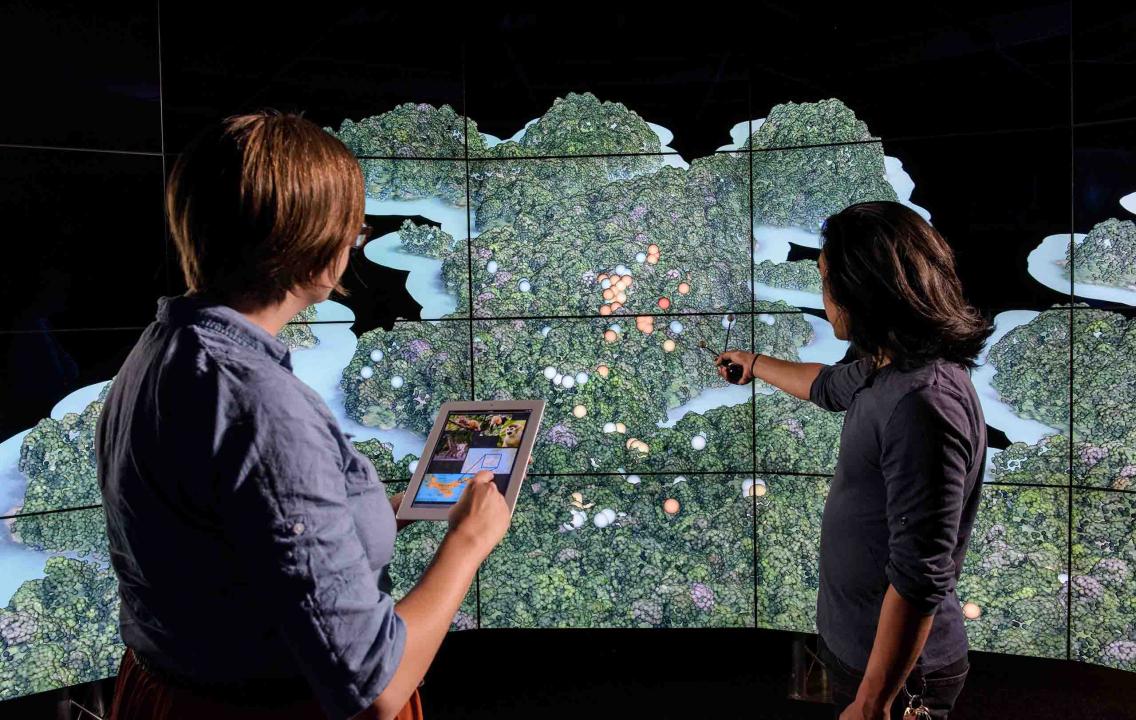|
|
||||||||||||||||||
COMPaaS DLV: Composable Platform as a Service Instrument for Deep Learning & Visualization
Researchers: Andrew Johnson, G. Elisabeta Marai, Lance Long, Luc Renambot, Maxine Brown, Mir Masood Ali, Timothy Bargo, Wei Tang, Zhongyi Chen
URL: https://compaas.evl.uic.edu/ Funding: NSF CNS-1828265 Project Period: October 1, 2018 - September 30, 2021 September 9, 2018 - The National Science Foundation (NSF) awarded a three-year grant to the UIC Computer Science (CS) Department’s Electronic Visualization Laboratory (EVL) to acquire the “Composable Platform as a Service Instrument for Deep Learning & Visualization (COMPaaS DLV)”. The total project cost is $1,424,806, with NSF providing $997,363 for hardware and the balance provided by UIC cost share to cover staff and graduate student support to design, operate and maintain the system. Maxine Brown, EVL Director, is Principal Investigator (PI) and co-PIs are CS faculty and EVL affiliated faculty members Andrew Johnson, Robert Kenyon and G. Elisabeta Marai. COMPaaS DLV will be acquired and made available for Deep Learning and Visualization research and training. Initial users will be 17 faculty from 5 departments in the UIC College of Engineering (COE) who provided compelling use cases for this system, and then expanded to other COE faculty as availability and demand permits. Users include the above-mentioned PI and co-PIs, plus COE Senior Personnel: Tanya Berger-Wolf (CS), Sybil Derrible (Civil & Materials Eng.), Barbara Di Eugenio (CS), Chris Kanich (CS), Alex Leow (BioEng/Psychiatry, and by courtesy CS), Bing Liu (CS), Farzad Mashayek (Mechanical & Industrial Eng.), Roberto Paoli (Mechanical & Industrial Eng.), Luc Renambot (CS), Philip Yu (CS), Milos Zefran (Electrical & Computer Eng.), Xinhua Zhang (CS), and Brian D. Ziebart (CS). COMPaaS DLV is critical infrastructure on which UIC faculty can pursue fundamental research in deep learning (data mining, data analytics, computer vision, natural language processing, artificial intelligence), visualization (simulation, rendering, visual analytics, video streaming, image processing), and a combination of deep learning and visualization (that is, when data is so large that it cannot be easily visualized, deep learning is used to extract features of interest to be visualized). UIC faculty are investigating, and contributing to, solutions for societal issues in such areas as anthropology, biology, cybersecurity, data literacy, fraud detection, healthcare, manufacturing, urban sustainability, and cyber-physical systems (e.g., autonomous vehicles). Though EVL specializes in visualization and virtual reality, it has a longstanding reputation as a technology enabler for the campus. EVL will design and operate COMPaaS DLV as a highly flexible, scalable, high-throughput system for Big Data. Its flexible 4th-generation computer architecture, “composable infrastructure,” treats computer components - computer processing units (CPUs), graphical processing units (GPUs), and storage - as pools of resources. Each application defines what resources it needs, and the operating system composes, or combines, resources on the fly and infrastructure is provisioned ‘right-sized’ and resized as needed. The system is easily scalable - new infrastructure is automatically integrated with existing infrastructure and becomes part of the pool of capacity. The system’s components are all interconnected with a high-speed internal network fabric, so that Big Data can quickly move between CPU, GPU and storage at optimum speed, i.e., high-throughput, with little to no bottlenecks. COMPaaS DLV will complement, but be connected via UIC’s research network, to campus and regional clusters, data storage, supercomputing and cloud testbed facilities managed by the UIC ACCC’s Advanced Cyberinfrastructure for Education and Research (ACER) group, the National Center for Supercomputing Applications at University of Illinois at Urbana-Champaign, Argonne National Laboratory’s Leadership Computing Facility, and University of Chicago. Access to COMPaaS DLV will enable faculty, students and postdocs to execute deep learning and visualization codes faster, apply more sophisticated models to large-scale problems, gain greater insights, accelerate discovery, and open new avenues of research. The instrument will enable UIC to recruit new faculty who are attracted to institutions that can support their computational needs, and to recruit new students and produce a better trained workforce - which in turn attracts industrial partnerships. See UIC Today News Release for more information. PHOTO CAPTION: One of the applications that will benefit from COMPaaS DLV is “SENSEI Panama,” a UIC collaborative project with evolutionary anthropologist Meg Crofoot (UC Davis) to enable anthropologists to use virtual reality to ‘walk inside their data’ and study animal behavior. Specifically Crofoot and UIC computer scientists Tanya Berger-Wolf, Andy Johnson and Maxine Brown, are applying Deep Learning and Visualization to process data from LIDAR, aerial photography, terrain maps, GPS collars, and accelerometers, in order to study how coatis, kinkajous, spider monkeys, and capuchin monkeys on Barro Colorado Island (a Smithsonian Tropical Research Institute Research Center) in Panama, forage for food. This project received some funding from the NSF SENSEI $3.5M award to UIC CS Maxine Brown (principal investigator) and UIC CS co-PIs Andy Johnson, Tanya Berger-Wolf, and Robert Kenyon. (This project/photo won Honorable Mention in the UIC 2016 Image of Research Competition). Date: October 1, 2018 - September 30, 2021 |